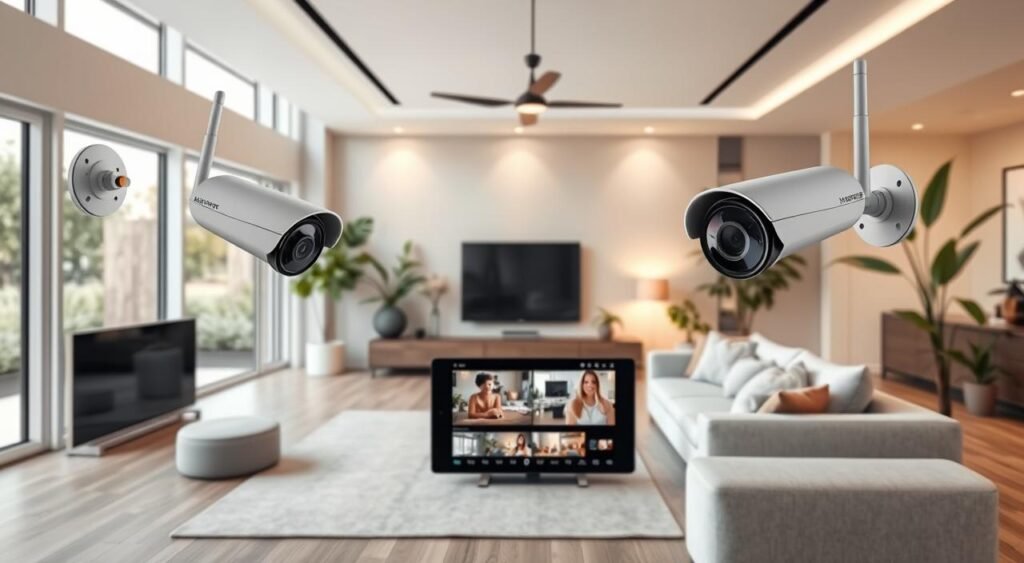Can your home’s style and safety ever truly coexist? Today’s home security camera systems are rewriting the rules. No longer do you have to choose between aesthetics and protection. With sleek designs from Arlo and sharp visuals from ADT, these systems enhance your decor while ensuring safety.
Ever wondered if wireless cameras are really secure? Or how to pick between 1080p clarity and 4K night vision? This guide cuts through confusion. Whether you’re upgrading a minimalist kitchen or securing a sprawling backyard, I’ll break down what matters most—privacy, resolution, and ease of use—so you make choices that fit your lifestyle.
Key Takeaways
- Wireless surveillance cameras offer convenience but may face hacking risks compared to wired options.
- Top brands like ADT (9.8/10) and Wyze Cam (8.3/10) balance affordability and performance.
- Modern systems let you pair 4K Lorex night vision with designs that hide discreetly in corners or blend into walls.
- Two-way audio and Alexa integration (like Ring’s features) turn cameras into interactive tools, not just observers.
- Professional installation boosts wired camera security, but DIY setups like SimpliSafe’s 9.2/10 score simplify setups.
The Evolution of Home Security Camera Systems
Imagine a time when home security was marked by bulky, obvious CCTV systems. Today, smart home monitoring has revolutionized how we safeguard our homes—without compromising on style. Let’s dive into the journey we’ve taken and its implications for your home.
From Basic CCTV to Smart Surveillance
It began in 1942 with Walter Bruch’s early CCTV systems for military use. By 1969, Marie Van Brittan Brown introduced a motorized camera system for home security. These systems were cumbersome, reminiscent of VCRs and thick cables. Fast-forward to today, and we see AI, 4K resolution, and cloud storage leading the charge. NVIDIA GPUs and TPUs power AI-driven analytics, transforming cameras into proactive protectors. The era of bulky CCTV systems is behind us, replaced by sleeker, smarter technology.
How Modern Systems Balance Aesthetics and Functionality
Today, design and defense converge in home security systems. Smart home monitoring solutions seamlessly integrate into your environment:
- Cameras disguised as wall art or smoke detectors
- IP66-rated outdoor models that complement modern architecture
- Apps that allow voice command control
The days of unsightly boxes are over. Brands like Arlo and Ring focus on sleek designs alongside advanced features like facial recognition.
The Growth of the Home Security Market
The transformation is significant: hybrid AI architectures merge edge and cloud processing, boosting system speed and scalability. Companies like Nest and SimpliSafe are integrating AI into existing systems. Why? Because 90% of homeowners now seek smart home monitoring that’s both effective and unobtrusive. The market is expanding rapidly—experts forecast a 12% annual growth rate through 2025. You’re part of a movement that values both style and security like never before!
Why Every Modern Home Needs Security Cameras
Peace of mind is not a luxury—it’s a necessity. With home security camera systems, you’re not just adding gadgets. You’re building a safeguard that turns worry into confidence. Did you know visible cameras deter 61% of would-be intruders?
“Security cameras act as a powerful deterrent against would-be intruders,” says SimpliSafe’s 2023 report, slashing theft risks instantly.
Imagine catching a package delivery, checking in on your dog, or spotting a stranger lurking. wireless home security lets you monitor your space anytime via your phone.
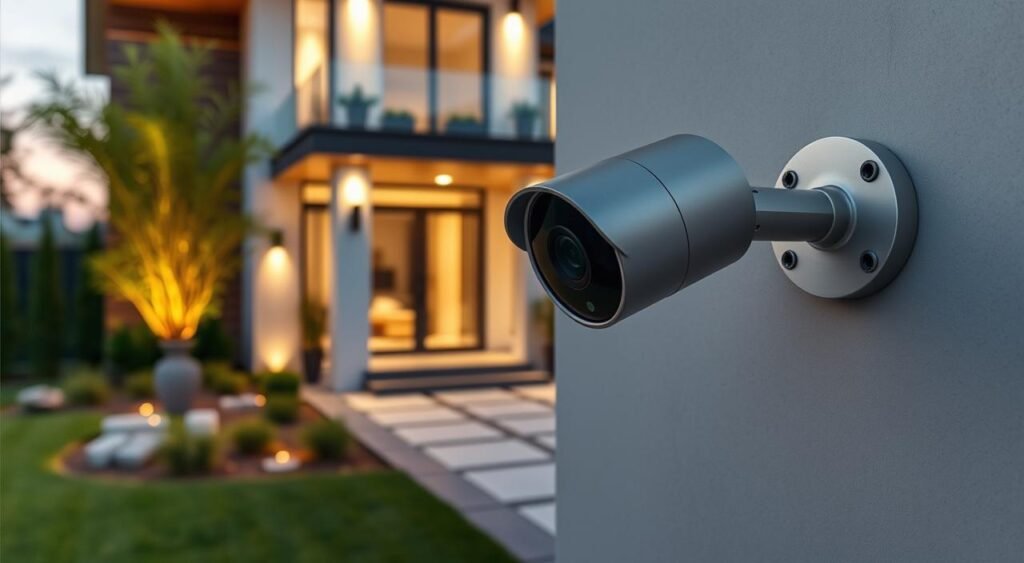
These systems aren’t just about stopping crime—they’re legal shields. High-resolution footage can serve as evidence in insurance claims or police investigations. And with wireless home security, setup is effortless. No messy wires! Plug-and-play models sync to your smartphone, providing live views and motion alerts.
- HD cameras capture every detail, even in low light.
- Two-way audio lets you confront intruders or greet guests remotely.
- AI-powered alerts filter out false triggers like passing cars.
Wireless options also boost resale value. Insurers may even lower premiums for homes with cameras. Ready to protect what matters? Start small—a single camera or a full system—and turn your home into a smart, secure sanctuary everyone can trust.
Types of Home Security Camera Systems Explained
Choosing the right security system begins with understanding your options. Let’s break down the basics to help you pick what fits your style and safety needs!
Wired vs. Wireless Security Cameras
Let’s compare two main setups:
| Type | Wired | Wireless |
|---|---|---|
| Power | Plug-in or hardwired | Batteries or solar (like the Reolink Argus 3 Ultra) |
| Installation | Requires professional setup | Easy DIY install |
| Cost | Higher upfront for wiring | Batteries need replacing yearly |
Indoor Security Cameras
Indoor cameras are sleek and blend into your space. Look for:
- Discreet dome or turret styles
- Two-way audio for clear communication
- 1080p HD or higher
Best Outdoor Cameras for Complete Coverage
Protect your property with options like:
- Bullet cameras – Sharp, fixed-angle monitoring
- Fisheye cameras – 360° views for driveways or gardens
- Reolink E1 Zoom – 355° pan, 5MP resolution, and Alexa/Google Assistant control
Always check the IP rating (IP65+ for rain/snow resistance) and night vision range.
Video Doorbell Systems
Upgrade your front door with smart doorbells like the Ring Video Doorbell Pro or Nest Hello. Features include:
- Live video feeds when someone rings
- Motion alerts and two-way talk
- Sync with smart locks and lights
Pair these with the best outdoor cameras for layered coverage. Questions? I’m here to help you mix style and safety!
Key Features to Look for in Security Cameras
Choosing the right surveillance cameras begins with understanding what’s essential. Let’s explore the critical features that transform ordinary cameras into robust home safeguards.
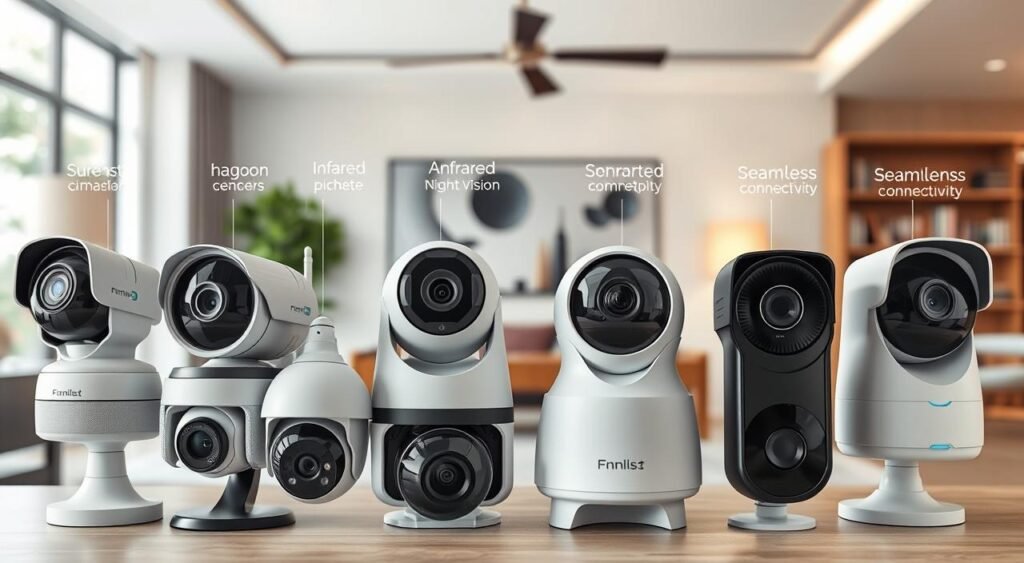
Resolution is key to the clarity of your footage. Opt for at least 1080p, but 4K models like the Arlo Pro 4 offer unparalleled detail for license plates or faces. Night vision is also critical. Full-color night vision, as seen in Reolink’s models, outshines traditional infrared red lights, providing sharper images in low light.
Resolution & Image Quality
- 4K/8MP: Captures facial details and license plates
- 2K/4MP: Affordable option for everyday monitoring
- Field of view: 130°+ for wider coverage
Night Vision Tech
Starlight sensors, found in Hikvision’s offerings, excel in near-total darkness. Full-color night vision, as seen in Nest Cam IQ, is perfect for driveways and entries.
Motion Detection & Alerts
- AI-driven alerts filter out pets or wind (Ring’s Dings system excels here)
- Adjustable zones let you ignore squirrels in the yard or passing cars
- Smartphone alerts for motion, sounds, or specific objects like packages
Two-Way Audio & More
Two-way audio is more than just for talking to guests—it’s a vital defense mechanism. Systems like the Wyze Cam V5 allow you to issue warnings or greet visitors without opening the door.
| Feature | Top Rated Security Cameras | Why It Matters |
|---|---|---|
| Resolution | Arlo Pro 4 (4K) | Identify faces/license plates |
| Night Vision | Reolink E2 Pro (Full Color) | Clear footage in darkness |
| Motion Detection | Ring Stick Up Cam | AI reduces false alarms |
“The right features turn cameras from gadgets into guardians,” says security pro Mark Thompson. “Prioritize what protects your home’s weak points.”
Remember, encryption and weatherproofing (IP66 rating) are essential for outdoor units. Combine these features to create a system that’s both efficient and powerful. Your home deserves technology that works as hard as you do!
Smart Integration: Connecting Your Camera System to Your Home
Imagine your security cameras seamlessly working with your lights, locks, and thermostat. This is the essence of smart home monitoring. With wireless home security systems, you’re not just adding cameras. You’re creating a smarter, safer environment. Let’s explore how simple it is to connect your cameras with other devices.
Begin by selecting cameras that integrate well with your preferred smart home systems. Brands like Nest, Ring, or Arlo are compatible with Amazon Alexa, Google Home, or Apple HomeKit. With a simple command like “Alexa, show my front camera,” you can check in anytime. You can also set up automations, such as lights flashing when motion is detected. Picture your door locks engaging automatically when you arm your system. This is the power of integration!
- Link cameras to smart bulbs for instant “hello” alerts
- Arm your system with a voice command
- Pair with smart locks for seamless access control
Compatibility is essential. Make sure your cameras use open protocols like Z-Wave or Zigbee to connect with non-ecosystem devices. Wireless home security systems allow you to manage everything through one app. This eliminates the need to juggle multiple apps. Plus, with encryption built-in, your data remains secure while you enjoy the convenience.
Not sure where to start? Begin with a simple setup: pair your first camera with a smart plug. Witness how automation can transform your daily routine. Each step brings you closer to a home that’s as intuitive as it is secure. Your stylish, tech-savvy sanctuary is waiting for you—without the need for complicated setups!
Top Rated Security Cameras for 2023
Choosing the right top rated security cameras requires a balance of style, technology, and budget. Here’s a breakdown of the must-have picks for 2023 to help you find the perfect fit:
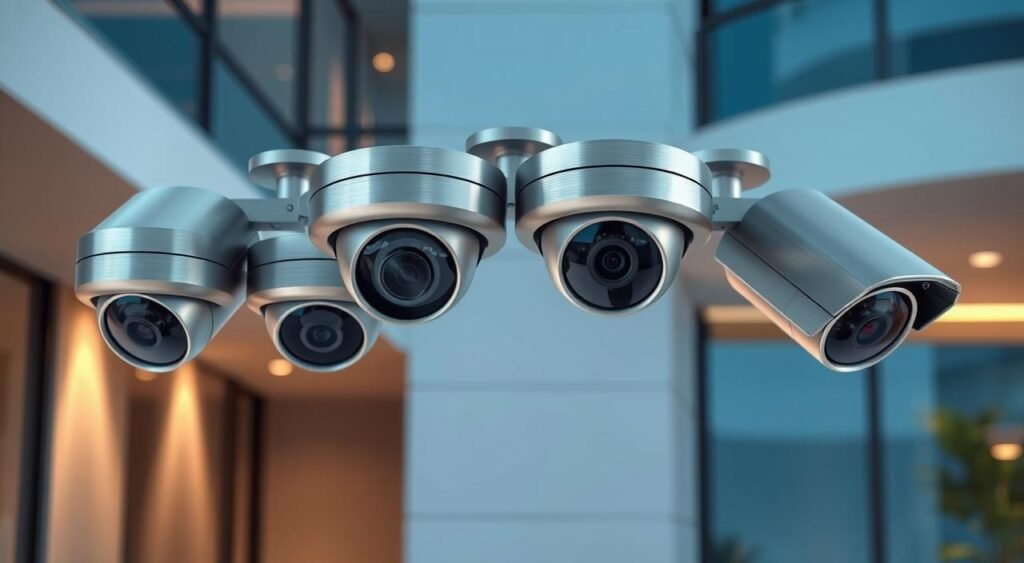
Best Overall Systems
For home security camera systems that offer both ease and power, consider SimpliSafe and Ring. SimpliSafe’s Intruder Intervention feature alerts you in real-time and offers 2K resolution. Ring’s Floodlight Cam adds two powerful spotlights and color night vision, ideal for driveways. Both systems integrate with Alexa/Google Assistant, fitting seamlessly into modern homes without compromising on style.
Budget-Friendly Options
- Wyze Cam v4: Offers 1440p video, color night vision, and free cloud storage at $24.99—$15 off! It’s perfect for renters or those with small spaces.
- Eufy Cam S350: Features 4K resolution, 360° panning, and no subscription fees. It detects packages, people, and pets with AI smarts.
Premium Security Solutions
For a step up, consider Arlo Ultra 2 with 4K video and a 6-month battery life, or ADT’s professional-grade systems with 24/7 monitoring. The Eufy Floodlight Camera E340 stands out with dual lenses and 24/7 recording. The TP-Link Tapo lasts 300 days on a single charge and can distinguish between pets and vehicles.
“The Eufy Floodlight’s activity zones saved me from false alerts—now I only get notifications I need.” – Verified Buyer
Remember to check encryption features and local/cloud storage options. Whether you’re starting or upgrading, these top rated security cameras offer peace of mind without compromising your home’s aesthetic. Ready to protect your space? Choose what fits your lifestyle and budget!
Understanding Remote Access Cameras and Mobile Monitoring
Imagine sipping coffee on a beach while checking your driveway via your phone—that’s the power of remote access cameras. These devices transform your smartphone into a 24/7 security center. They combine advanced technology with user-friendly design. Let’s explore how this works without technical jargon!
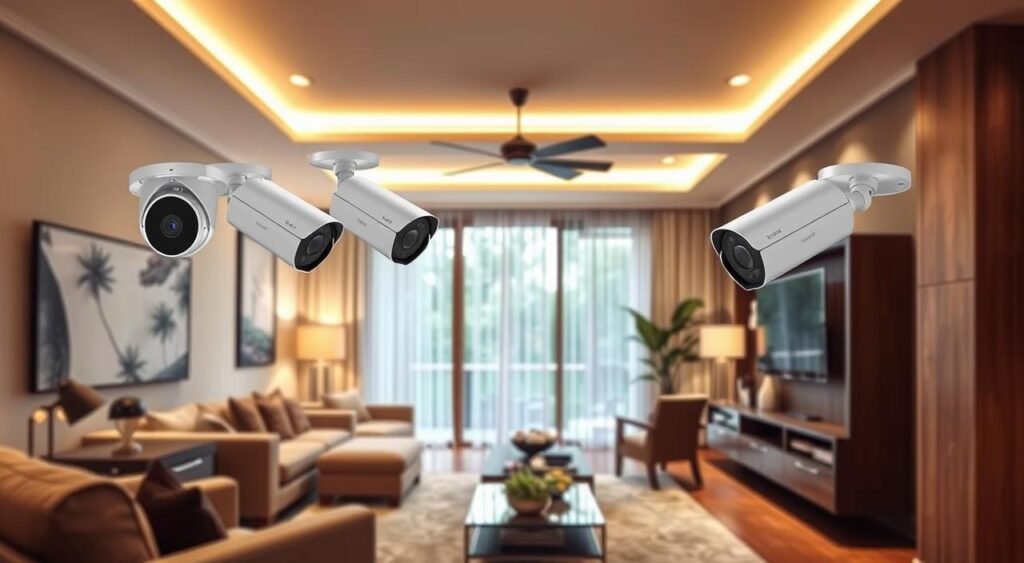
How Remote Viewing Works
Remote access cameras connect to your home’s Wi-Fi or cellular network. They stream footage through secure apps like Honeywell’s Lyric Controller or DSC’s Alarm.com platform. With Z-Wave® technology, you can control systems or lock doors from afar. Encryption ensures your footage remains secure, akin to military-grade protection.
Setting Up Mobile Alerts and Notifications
- Download your camera’s app (like Arlo or Ring) and log in.
- Enable real-time alerts for motion, sound, or face recognition.
- Customize zones—“alert me if someone enters the backyard, not the neighbor’s yard!”
- Test push notifications and two-way audio to shoo off suspicious visitors.
Cloud Storage vs. Local Storage Options
| Cloud Storage | Local Storage |
|---|---|
| Stores footage on remote servers (e.g., Nest Aware) Access anywhere with internet Auto-updates and backups | Saves to microSD cards or a local NVR No monthly fees after purchase Risk if hardware fails |
Choosing between cloud and local storage depends on your preferences. Do you prefer the convenience of cloud access or the cost-effectiveness of local storage? Either way, consider AI-powered features like Coram’s video analytics for quicker threat detection. Remember, your home’s security should be as intuitive as your favorite app!
Designing a Comprehensive Home Security Camera System
Creating an effective home security camera system that blends into your home requires careful planning. It’s akin to arranging furniture, where each camera has a specific role and location. Let’s explore the steps involved:
- Map Your Space: Walk through your property, marking entry points, blind spots, and high-risk areas. Focus on doorways, windows, and driveways.
- Layer Your Defense: Combine best outdoor cameras with indoor models. Outdoor cameras cover the perimeter, while indoor ones protect the interior.
- Blend Form with Function: Opt for sleek designs that complement your home’s aesthetic. Mount cameras at 8–10 feet high to prevent tampering and conceal wiring.
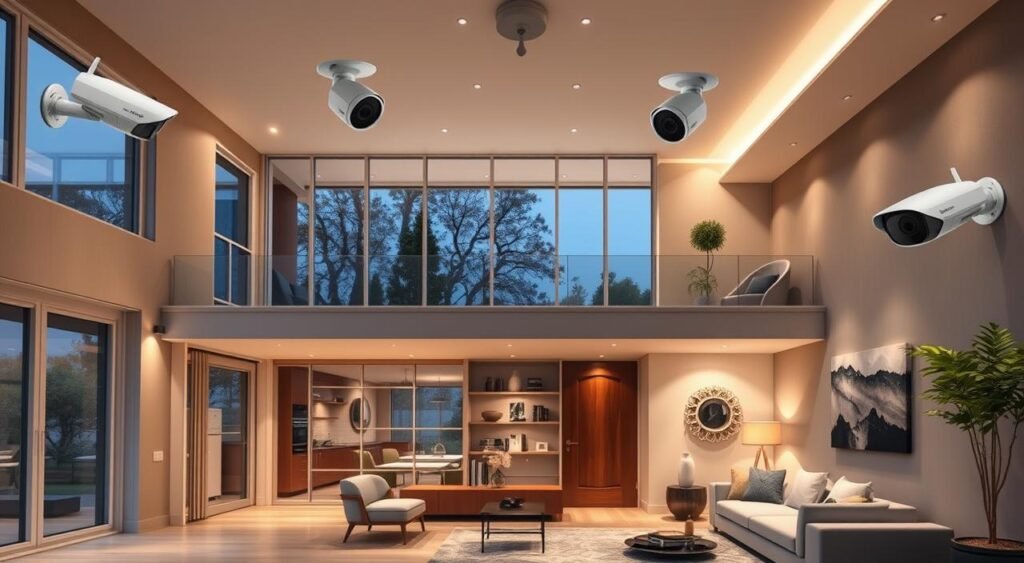
| Feature | Indoor Cameras | Outdoor Cameras |
|---|---|---|
| Key Features | Two-way audio, privacy shutters | Weatherproofing, night vision, solar options |
| Placement Tips | Kitchens, hallways, living areas | Garages, porches, fences |
| Budget Tips | Wireless models save on installation | Opt for rechargeable batteries in remote areas |
“A well-designed system doesn’t just watch—it communicates. Cameras with motion alerts and real-time feeds turn passive observation into proactive protection.”
Begin with your front door. Use a best outdoor camera with wide-angle lenses here—they cover driveways and walkways without clutter. For backyards, pair motion-activated units with floodlights to deter intruders. Always test angles and lighting at different times of day to avoid blind spots.
A great setup isn’t just about quantity. It’s about thoughtful placement and integration. Whether you’re protecting a studio apartment or a sprawling estate, these strategies turn your home security camera systems into a seamless extension of your home’s design.
Installation Guide: DIY vs. Professional Setup
Setting up your wireless home security system doesn’t have to be daunting. We’ll explore your options to find the best fit for your abilities and preferences.
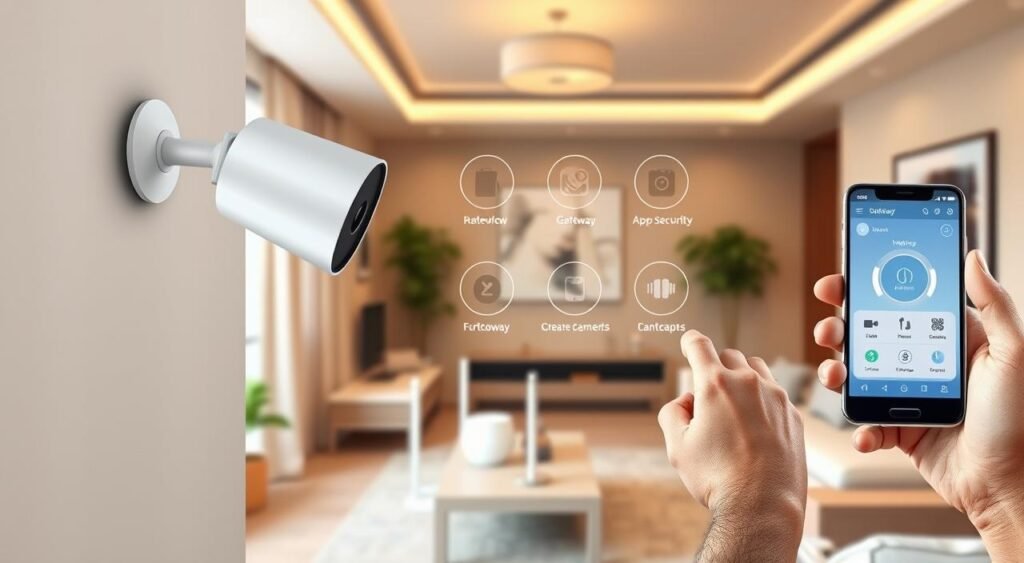
Tools and Equipment Needed for Self-Installation
Embarking on a DIY project? Here’s what you’ll need:
- Drill or screwdriver for mounting
- Ladder for high placements
- Measuring tape for precise spacing
- Toolkit from brands like SimpliSafe or Ring, which include all hardware
Wireless systems, such as CCTV systems from Nest or Arlo, can be set up in 30 minutes to 3 hours. Follow the app’s instructions—no need for complicated wiring!
When to Call the Professionals
Consider professional help for these situations:
- Complex layouts needing multi-camera coverage
- Integration with existing CCTV systems or smart home tech
- Need for 24/7 monitoring via ADT or Vivint
Services like TaskRabbit or Thumbtack offer nationwide assistance starting at $99. Their expertise ensures a smooth setup, even for complex systems.
Common Installation Challenges and Solutions
Encountering issues? Here are some fixes:
- Weak Wi-Fi signal? Use a range extender or place cameras closer to routers.
- Power source issues? Opt for battery-powered cameras like Ring Stick Up Cam.
- Weather concerns? Choose weatherproof models like Reolink’s outdoor cameras.
Stuck? Most brands offer free lifetime support. Ring, for example, provides live chat and video tutorials. Remember, professional installers can handle tricky spots like attic mounting or hidden wiring.
Privacy Considerations for Home Surveillance
Protecting your family doesn’t mean you have to give up privacy. It’s about finding a balance between security and respect for personal and neighborly space. Surveillance cameras are invaluable tools, but how you use them is key. Here’s how to ensure safety without crossing boundaries:
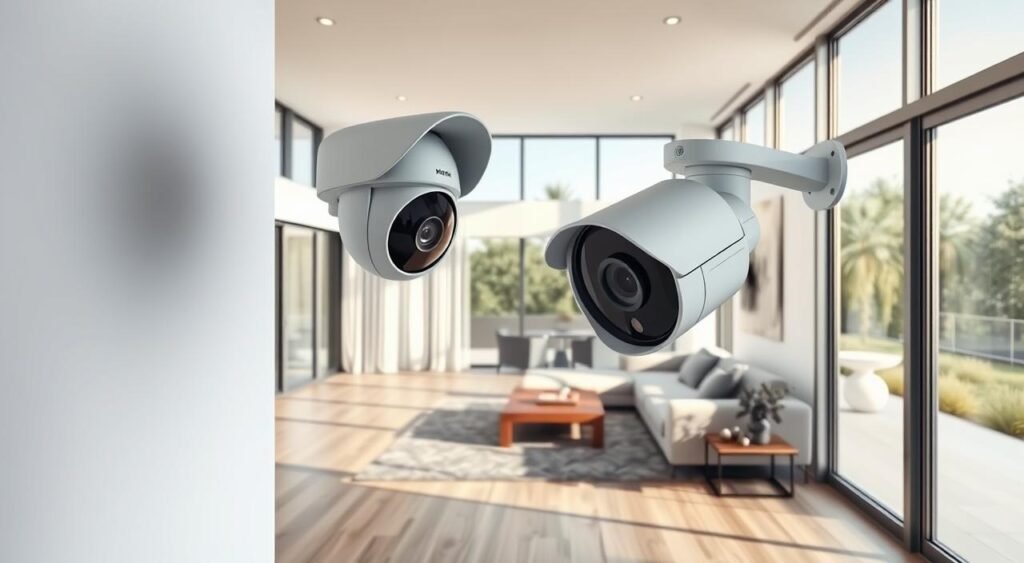
- Placement matters: Position remote access cameras to monitor entryways, not into neighbors’ windows or private areas. Use privacy zones to obscure sensitive spots like doors or driveways.
- Secure your network: Use robust passwords for Wi-Fi and cameras—hackers prey on weak ones. Enable two-factor authentication for remote access.
- Storage choices: Prefer local storage (like SD cards) over cloud services to minimize data-sharing risks. Regularly delete old footage.
“You have the right to refuse sharing footage without a warrant—but always comply with legal requests,” advises the FTC.
Inform guests and family about camera locations. Post signs near entrances to set expectations. Avoid recording in bedrooms or bathrooms, and use motion detection to limit unnecessary recording. Brands like Nest and Ring now offer encryption features—check your system’s privacy settings regularly.
As technology advances, so do solutions. Prioritize ethical use—your security shouldn’t invade others’ space. Stay vigilant, update firmware, and balance safety with respect for privacy. Your home stays secure, and your peace of mind stays intact.
Maintenance Tips to Keep Your Security System Running Smoothly
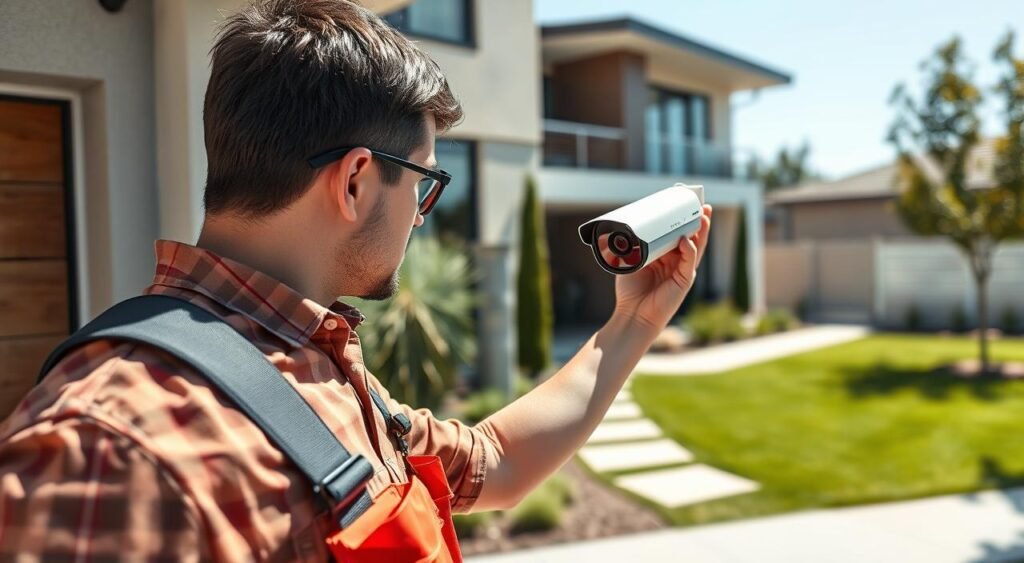
Regular upkeep ensures your home security camera systems stay reliable. Let’s break down three steps to simplify your routine:
Regular Cleaning and Inspection
Cameras with clogged lenses or dusty sensors can’t capture clear footage. For outdoor units, wipe lenses monthly with a soft cloth—avoid abrasive materials. Indoor models need cleaning every six months. Check mounts for stability and inspect wiring for damage. Pro tip: Use microfiber cloths and lens-cleaning solutions designed for electronics.
Software Updates and Security Patches
Outdated software leaves systems vulnerable. Enable automatic updates for top rated security cameras like Nest or Arlo. Schedule quarterly manual checks to ensure patches are applied. This prevents hacking risks and keeps features updated.
Troubleshooting Common Problems
- Blurry Footage: Clean lenses or adjust camera positioning.
- No Connectivity: Restart routers or check Wi-Fi signals.
- False Alerts: Adjust motion detection zones in the app settings.
| Task | Frequency | Priority |
|---|---|---|
| Lens Cleaning | Monthly (outdoor) | High |
| Firmware Updates | Quarterly | Critical |
| Weatherproof Checks | Bi-annually | Medium |
Small habits like these keep your system sharp and secure. Need help? Most top rated security cameras offer customer support for troubleshooting. Prioritize these steps to avoid costly repairs and enjoy years of reliable protection!
“Maintenance is the secret to longevity,” says industry experts. “A few minutes a month prevent major headaches later.”
Ready to get started? Follow this guide to turn maintenance into a breeze—and keep your home’s style and safety intact.
Cost Analysis: Initial Investment vs. Long-Term Value
When you’re in the market for wireless home security, the sticker price isn’t the only thing to consider. It’s essential to understand the true cost implications. Hidden expenses can significantly add up over time.
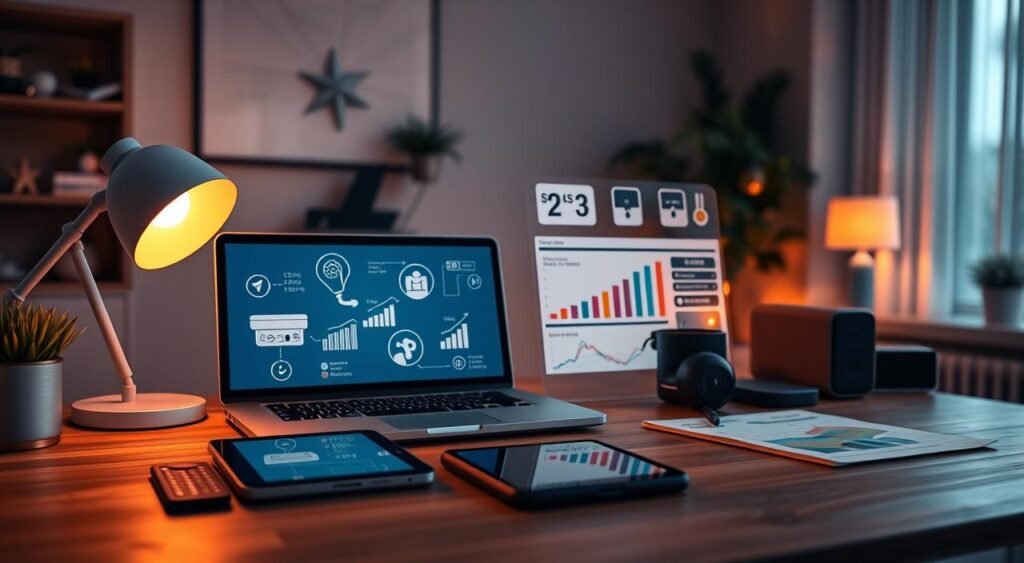
The reality is stark: 70% of total costs emerge after the initial setup. Opting for systems with low initial costs might lead to higher subscription fees down the line. Let’s examine the details:
| Cost Type | Example | Impact |
|---|---|---|
| Initial | Buying video doorbells like Ring or Nest | Upfront expense |
| Recurring | Cloud storage plans ($5–$10/month) | Monthly fees add up fast |
| Hidden | Replacement batteries (every 6–12 months) | Easy to overlook but critical |
Consider this example: A small business invested in AI-powered cameras and saw a 399% ROI over five years. Their initial investment was higher, but the savings from reduced theft and insurance premiums were substantial. Reflect on your own situation:
- Do I need 24/7 cloud storage or can I use local drives?
- Will wireless home security save on installation labor?
- Are video doorbells like Arlo or SimpliSafe worth the premium?
For instance, budget-friendly options like Wyze start at $30. Yet, their longevity might not match more expensive alternatives. Use this framework to make an informed decision:
“Think of security as an investment—not an expense. Preventing one break-in pays for years of monitoring.” – Home Security Advisors Association
Begin by identifying your essential features. Focus on aspects like motion detection or video doorbells with two-way audio. Next, compare the total costs over 3–5 years. Finding the right balance between aesthetics and affordability is achievable. Let’s explore it together!
How Smart Home Monitoring Transforms Daily Living
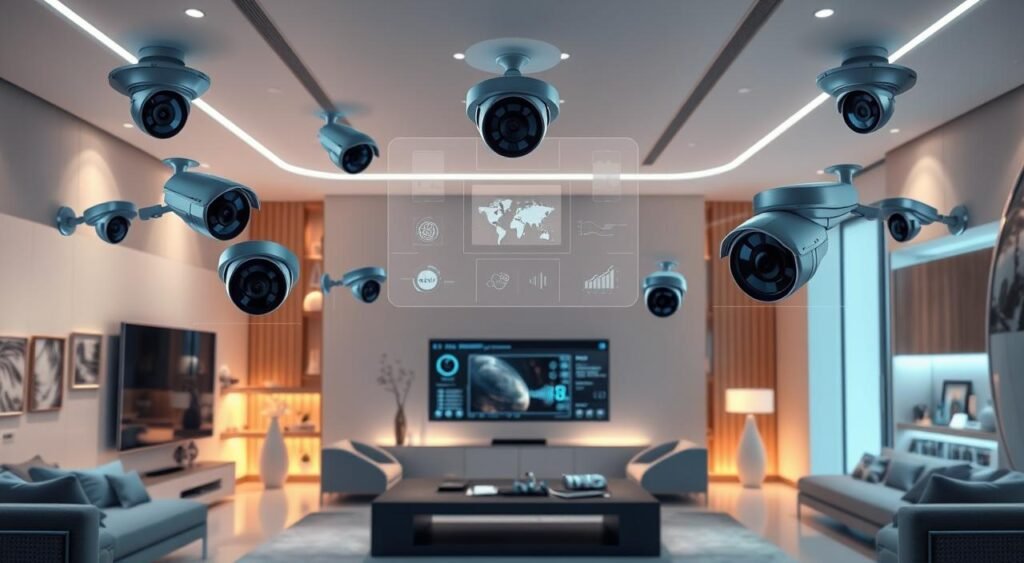
Smart home monitoring is more than security; it’s a lifestyle enhancement. Imagine asking Alexa to check your porch via remote access cameras while enjoying your coffee. This is the power of today’s systems. These tools transform your home into a responsive, secure environment.
Integration with Voice Assistants
Imagine cooking dinner and saying, “Alexa, show the front door.” Instantly, your smart TV displays a live feed from your camera. Voice commands allow you to arm systems, review footage, or mute alerts hands-free. Brands like Google Nest and Ring offer this seamless control, combining style with convenience.
Automating Security Responses
- Motion detected? Outdoor lights flash—scaring intruders automatically.
- Smart locks lock when you say “goodnight” to Alexa.
- Thermostats pause when no motion is sensed for hours.
These actions reduce stress. Pro tip: Use Apple HomeKit’s “Away Mode” to randomize light schedules, tricking burglars into thinking you’re home.
Creating Custom Security Scenarios
| Scenario | Action | Benefit |
|---|---|---|
| Evenings | Cameras + porch lights activate at sunset | Deterrence and visibility |
| Vacation Mode | Randomized camera feeds + fake activity alerts | Confuse intruders |
| Weather Alerts | Close garage doors during storms | Protect property automatically |
Custom setups like these reduce anxiety. With 60% fewer break-ins in smart homes, the data is clear. Need help starting? Begin with remote access cameras and voice commands. Each step adds peace of mind without the high cost.
Legal Aspects of Home Security Cameras
Thinking about installing surveillance cameras or CCTV systems? It’s essential to understand the legal aspects to avoid any issues. Laws differ significantly by location, so it’s critical to be aware of them.
In California, homeowners must adhere to strict guidelines. No audio recording is allowed without consent, as stated in Penal Code 632. Even if your surveillance cameras are set to capture motion, recording audio requires explicit permission. Pointing cameras at neighbors’ private areas is strictly prohibited. California’s Penal Code 647(j)(3) explicitly bans recording in areas where individuals expect privacy, such as backyards or bedroom windows.
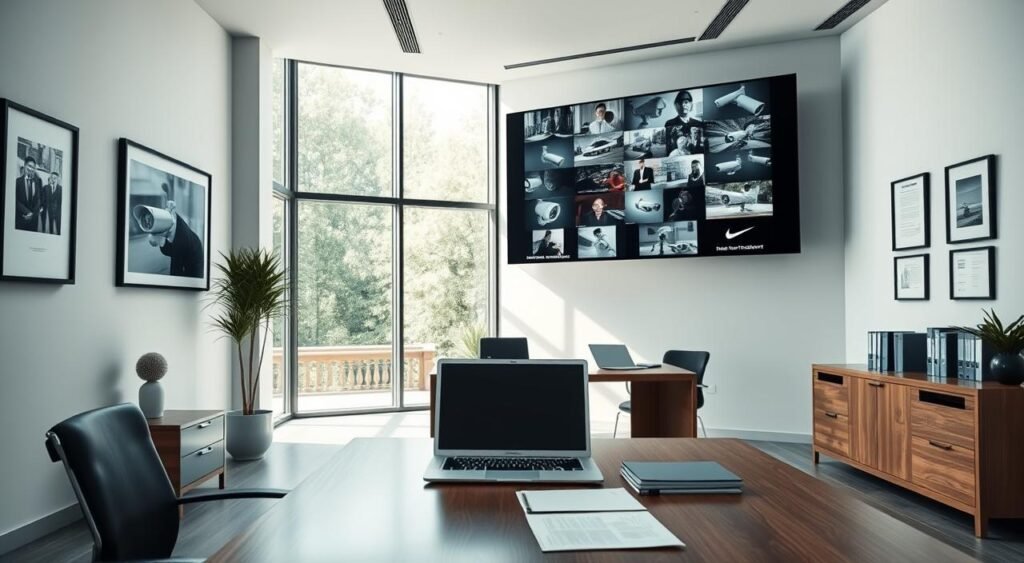
- Never install CCTV systems facing into neighbors’ private spaces
- Post visible signage if you use surveillance cameras—this deters disputes
- Storage retention over 30 days? Check local data laws
“Recording without consent in private areas is a criminal offense in California.” — California Penal Code 647(j)(3)
Curious about installer licenses? In California, only contractors with a C-7 license can legally install security systems. Kathy Griffin’s 2019 case is a good example. Her cameras were directed at a neighbor’s yard, which was deemed legal as it didn’t invade privacy. Yet, passive recording can also breach laws if it captures someone’s private moments.
Before setting up your system, ask yourself: Does it respect others’ privacy? Always review local regulations through official resources and consult a legal expert. Being informed is key to safeguarding your home and rights.
Conclusion: Creating Your Perfect Balance of Style and Security
Your home should be both beautiful and secure. Today’s home security camera systems offer the best of both worlds. The Reolink Argus 4 Pro and Eufy Floodlight Camera combine stylish designs with cutting-edge features like AI detection and 360-degree views. Begin with essentials like the ZOSI C291 4K PoE Kit, which uses solar power and local storage to save costs and simplify setup. Even small steps can make a difference, such as the Ring Spotlight Cam Pro’s discreet design or the Noorio B210’s customizable zones, allowing you to focus on style without compromising safety.
View security as a continuous journey, not a single task. Systems like SimpliSafe allow you to choose which doors or windows to monitor, adapting as your needs evolve. With professional monitoring starting at just $10/month via Ring Alarm, you receive 24/7 support—essential in emergencies like fires that can escalate rapidly. And remember, not all systems require subscriptions; cameras like the Psync Cam Genie S offer smart features without ongoing fees.
Picture your porch illuminated by the Eufy E340’s 2,000-lumen lights, or a Reolink camera monitoring your garden without appearing out of place. Each decision you make, from placement to technology, adds layers of protection without disrupting your home’s aesthetic. Future advancements will further enhance this balance, with smarter sensors and seamless smart home monitoring. But don’t wait—start today with what aligns with your budget and preferences. Your home’s safety and style deserve a system as unique as you are.
FAQ
What are the main benefits of installing home security camera systems?
Home security camera systems protect against intruders, offer peace of mind when away, and monitor deliveries and pet sitters. They also provide insurance discounts, making them a valuable investment.
How do I choose between wired and wireless security cameras?
Wired cameras ensure a stable connection but are more challenging to install. Wireless cameras are easier to set up and offer flexibility. Your choice should align with your specific needs and installation environment.
What should I look for in resolution and image quality?
Opt for at least 1080p resolution for sharp images, now the standard. For detailed captures like faces or license plates, consider 2K or 4K. Higher resolutions significantly enhance identification in various scenarios.
Do outdoor security cameras need to be weather-resistant?
Yes, outdoor cameras must withstand rain, snow, and extreme temperatures. Look for IP ratings that indicate their resistance to moisture and dirt.
Can I integrate my security camera system with smart home devices?
Yes! Many modern cameras integrate with smart home systems. This allows control via voice commands with Alexa, Google Assistant, or Siri. You can also automate interactions with other devices like lights and smart locks.
How do I set up remote access for my security cameras?
To enable remote access, most systems connect to your Wi-Fi and use user-friendly apps. Ensure your network is secure and follow the manufacturer’s setup instructions.
Why are video doorbells popular?
Video doorbells combine surveillance and intercom functions. They offer real-time notifications, recorded footage, and two-way audio, boosting front door security.
What maintenance do security cameras require?
Regular cleaning, firmware updates, and seasonal checks are essential. This ensures your system operates at peak performance and identifies issues early.
Are there legal concerns I should know about before installing my cameras?
Yes, understanding home surveillance laws is critical. Familiarize yourself with audio recording consent laws and camera placement rights to comply with regulations and respect privacy.
What’s the average cost range for home security camera systems?
Costs vary based on system type, camera number, and features. Expect to find options from under 0 to several hundred dollars for advanced systems.
